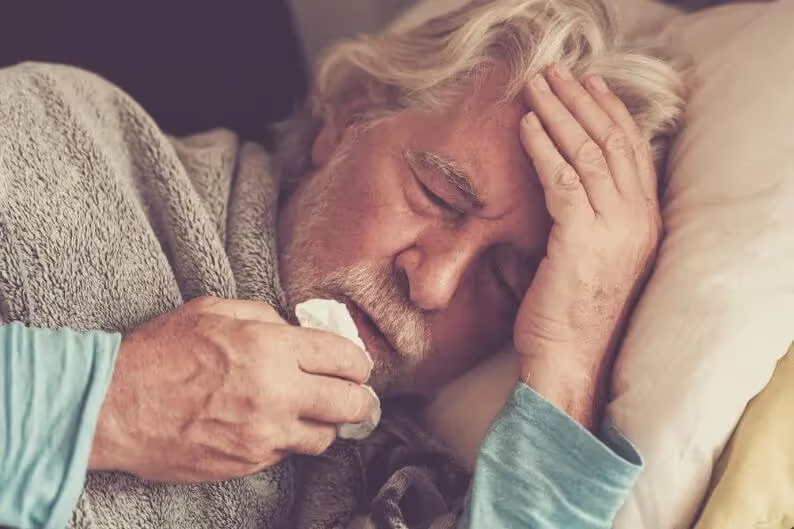Pneumonia is the second most common cause of hospitalization in the U.S., according to the American Thoracic Society. Adults age 65 and older are at a higher risk of getting pneumonia and dying from it than the younger population. With an increased risk, it's not hard to see why it's important to know how to prevent pneumonia in the first place.
Here's everything you need to know about what pneumonia is, the different types and stages there are, and things you should do to lower your chances of catching it.
What is Pneumonia
Pneumonia is an infection of the lungs. The air sacs in your lung(s) will fill with fluid or pus. It is caused by bacteria, viruses, and fungi. There are many signs and symptoms of pneumonia, including:
- Cough
- Difficulty breathing
- Chest pain when breathing or coughing
- Fatigue
- Fever
- Chills
- Confusion or changes in mental awareness
If you do contract pneumonia, it can be anywhere from just a mild case all the way to life-threatening. Infants, young children, and older adults experience the most serious cases. Those with health conditions or weakened immune systems are also at a higher risk of having a serious case.
The bacteria and viruses (such as COVID-19, a cold, or the flu) that cause pneumonia are contagious. An infected person spreads those germs through respiratory droplets. Those droplets are expelled into the air when you sneeze, cough, or breathe. When someone else inhales the droplets, they can contract the illness.
Types of Pneumonia
Knowing how the illness spreads and the different kinds will play a major part in learning how to prevent pneumonia. There are four main types we will focus on.
Community-Acquired Pneumonia
The most common type of pneumonia is community-acquired pneumonia. This is the type you get outside of a hospital or healthcare facility. It can be caused by bacteria, bacteria-like organisms (this kind usually gets the term "walking pneumonia" because it doesn't often require bed rest), fungi, and viruses (like COVID-19 and colds or the flu).
Hospital-Acquired Pneumonia
This type you catch while you're staying in a hospital. Hospital-acquired pneumonia can be very serious because it's a bacterial infection that may be more resistant to antibiotics and the people who catch it are already sick. You're at a higher risk of catching this type if you're on a ventilator.
Health Care-Acquired Pneumonia
This bacterial pneumonia occurs in people who are staying in long-term care facilities or get care from outpatient clinics (kidney dialysis centers, for example). Health care-acquired pneumonia is similar to hospital-acquired pneumonia in that it can be more resistant to antibiotics.
Aspiration Pneumonia
Aspiration pneumonia can happen when you breathe something in instead of swallowing it. The germs from the substance you inhaled instead of swallowed can infect the airways and cause aspiration pneumonia. Most of the time healthy lungs can handle those germs. This type is more common in older adults and young children.
What are the 4 Stages of Pneumonia
There are two main types of bacterial pneumonia: bronchopneumonia and lobar pneumonia.
Bronchopneumonia starts in the bronchi, which are the airways that lead from your windpipe into your lungs. The infection then works its way downward in both lungs.
With lobar pneumonia, one or more sections (called lobes) of the lungs are affected.It's divided into four stages depending on its progression.
1. Congestion
The first stage is congestion. Your lungs will feel heavy and congested because of the fluid that has built up. This is the time when you'll start feeling symptoms like coughing, a heavy chest, fatigue, and loss of appetite.
2. Red Hepatization
Stage two is red hepatization. During this stage, your lungs will look more red because of the red blood cells and immune cells moving in to fight the infection. You will have symptoms like a worse cough, shortness of breath, blue lips or fingernails, and other flu-like symptoms.
For older adults, this is where confusion or other changes in mental awareness may occur. If severe symptoms start, you need to get emergency treatment quickly.
3. Gray Hepatization
The infection then moves to the third stage, gray hepatization. The red blood cells that came to combat the illness disintegrate, which leaves the lungs looking a more grayish color. The immune cells are still there, but you are still likely to experience symptoms.
4. Resolution
Finally, you'll move to stage 4: resolution. This is where older adults will start to feel better. The immune cells are being successful in ridding the body of the infection. There may still be a cough, but it's a good cough. It will help your body get rid of the fluid that's left in your lungs.
How to Prevent Pneumonia
As for how to prevent pneumonia, there are several simple steps you can take.
The first one is to get vaccinated.Getting your flu shot every year is a great preventative measure because the flu is the most common cause of pneumonia. Older adults should also get vaccinated against pneumococcal pneumonia. There are also other vaccines that help prevent bacterial and viral infections and can protect you against pneumonia. Talk to your doctor about which ones may be right for you.
Practicing good hygiene is also key. Perhaps the easiest thing you can do is wash your hands regularly. Washing your hands can help prevent the spread of germs that lead to pneumonia. Make sure to wash your hands thoroughly at least after blowing your nose, using the bathroom, or before eating.
Finally, just make sure you're staying generally healthy. Lead a healthy lifestyle by eating right and getting enough regular exercise. Staying in good health will help keep your body in top condition so it can protect you against those bacteria and viruses that can lead to pneumonia. If you do start noticing some symptoms that hang around for more than a few days, go ahead and see your doctor so you can get out in front of any issues that may be popping up.




